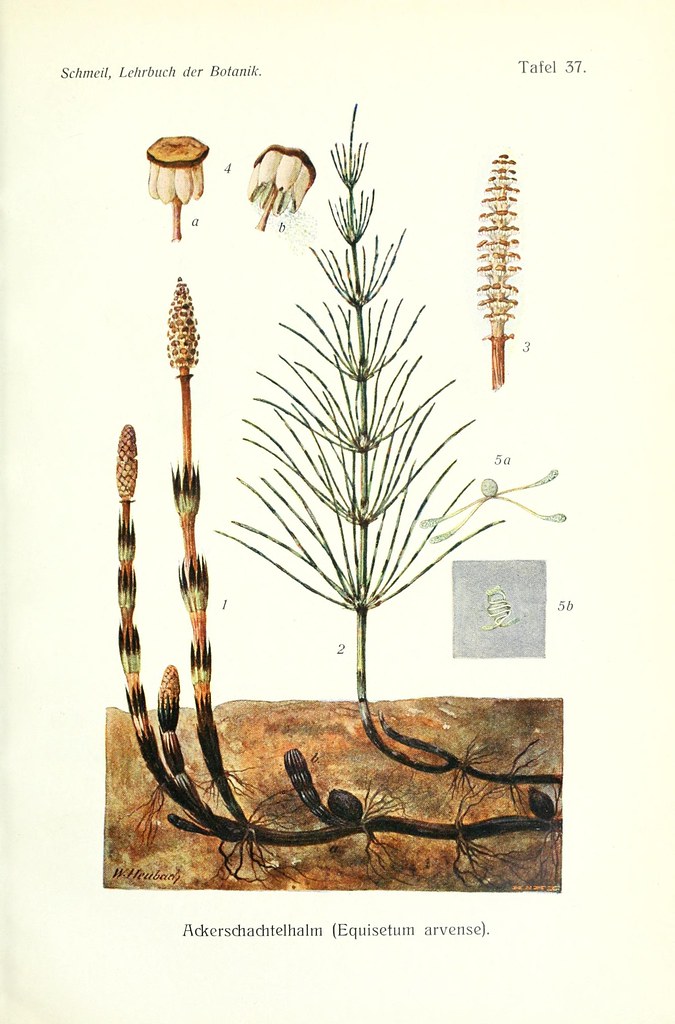#field horsetail
Text

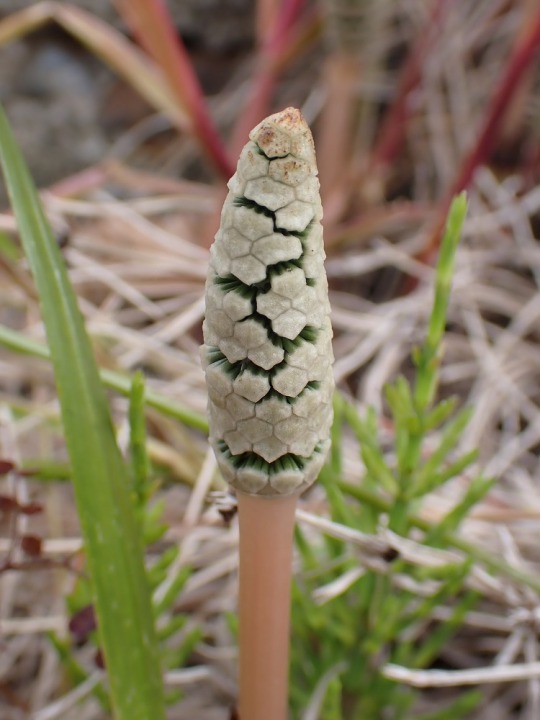
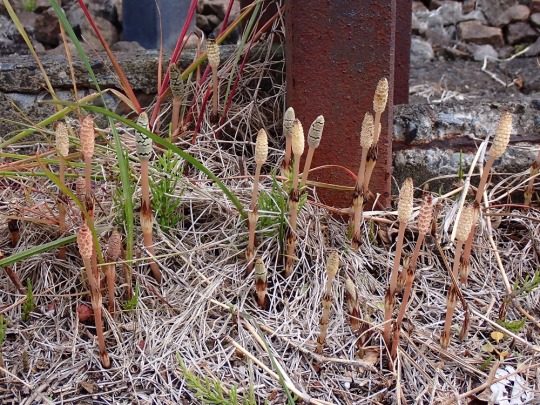
線路沿いにツクシが出てきた。六角形の若い胞子嚢が好ましい(3月7日)
Skrzyp polny (Equisetum arvense)
field horsetail or common horsetail (Equisetum arvense)
25 notes
·
View notes
Video
n452_w1150 by Biodiversity Heritage Library
Via Flickr:
Lehrbuch der Botanik;. LeipzigQuelle & Meyer1911. biodiversitylibrary.org/page/22538212
#Botany#Gerstein - University of Toronto (archive.org)#bhl:page=22538212#dc:identifier=http://biodiversitylibrary.org/page/22538212#Equisetum#University of Toronto - Gerstein Science Information Centre#Equisetum arvense#field horsetail#common horsetail#botanical illustration#scientific illustration
1 note
·
View note
Video
20230413 Shirakawago 5 by Bong Grit
Via Flickr:
田んぼのあぜにはつくしがニョキニョキ。土の筆とはうまく表現したもんだ。 @Shirakawago, Takayama city, Gifu pref. (岐阜県高山市 白川郷)
#Horsetail#Rice field#Rice paddy#Field#Mountain#Forest#Trees#Tree#Nature#Plant#Country#Countryside#Rural area#Mountainous area#Thatched roof#Gassho tsukuri#Japanese house#Old house#World Heritage Site#UNESCO World Heritage Site#Shirakawago#Shirakawa village#Ogimachi village#Takayama#Gifu#Japan#RICOH#RICOH GR3x#flickr
2 notes
·
View notes
Photo
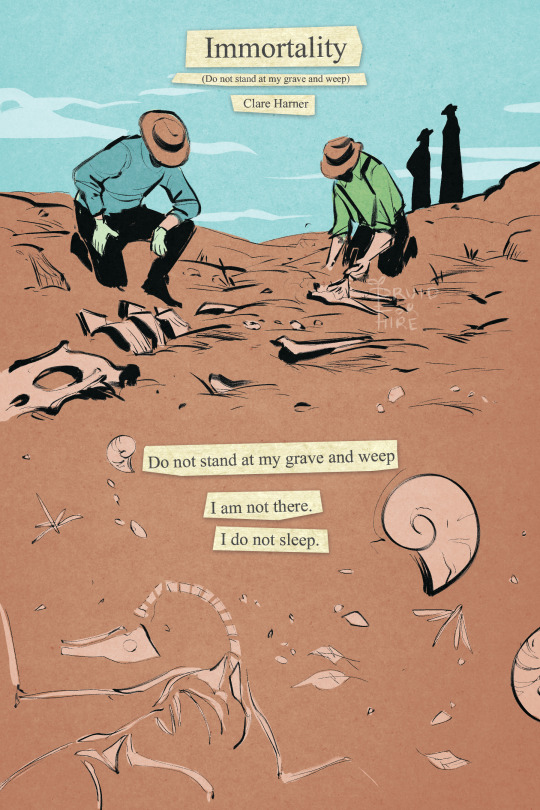

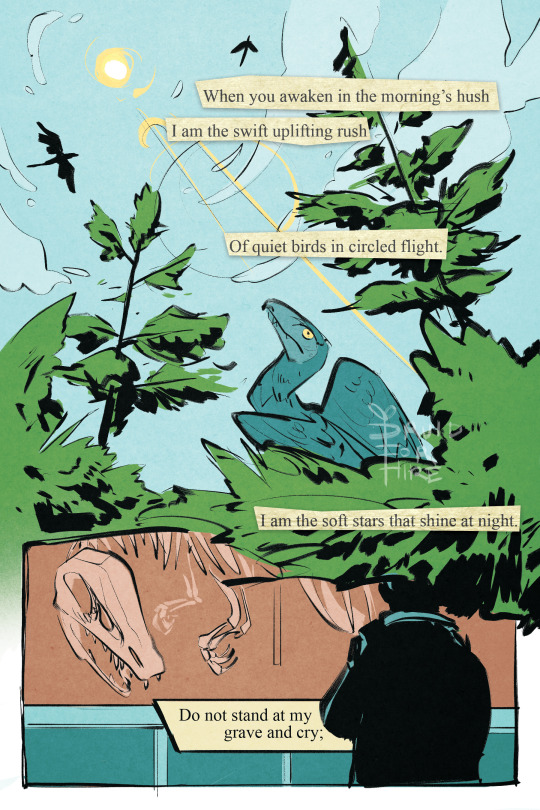
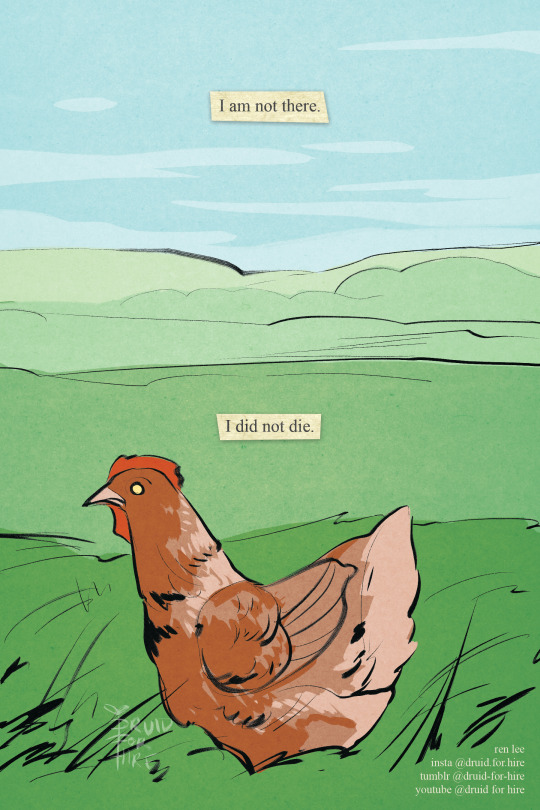
[image id: a four-page comic. it is titled "immortality” after the poem by clare harner (more popularly known as “do not stand at my grave and weep”). the first page shows paleontologists digging up fossils at a dig. it reads, “do not stand at my grave and weep. i am not there. i do not sleep.” page two features several prehistoric creatures living in the wild. not featured but notable, each have modern descendants: horses, cetaceans, horsetail plants, and crocodilians. it reads, “i am a thousand winds that blow. i am the diamond glints on snow. i am the sunlight on ripened grain. i am the gentle autumn rain.” the third page shows archaeopteryx in the treetops and the skies, then a modern museum-goer reading the placard on a fossil display. it reads, “when you awaken in the morning’s hush, i am the swift uplifting rush, of quiet birds in circled flight. i am the soft stars that shine at night. do not stand at my grave and cry.” the fourth page shows a chicken in a field. it reads, “i am not there. i did not die” / end id]
a comic i made in about 15 hours for my school’s comic anthology. the theme was “evolution”
#dinosaur#evolution#comic#prehistoric#animal#wildlife#paleontology#biology#poetry#comics#original#my art#archaeopteryx has no direct living descendants i know#but i wanted something aerial and the dinosaur to bird connection is classic and well known anyway#also the chicken over any other bird is very on purpose#its the mix of truth and comedy and genuineness and the fantastic in the mundane#its me asking you to see something so wonderful in something taken so un-seriously#and to love it both ways#also the jurassic park thing#where someone saw the reconstructed gait of a dino#and said. hey hang on. i know that walk.#and pulled up footage of a chicken walking#which jumpstarted the entire study into the link between dinosaurs and birds#in the end take whatever you want from it i just thought id provide some insight#i always like it when other artists do#the point is that i enjoy when people laugh at the end and when they dont#and i like it when they cry. i like it best when they both laugh and cry. eeaao intent#anyway mourn your losses but to live is to change#also hi guys i finally figured out tipping after 5 months so no more annoying ko-fi link
146K notes
·
View notes
Text
the harveston sledathon event: jade leech's "incantation"
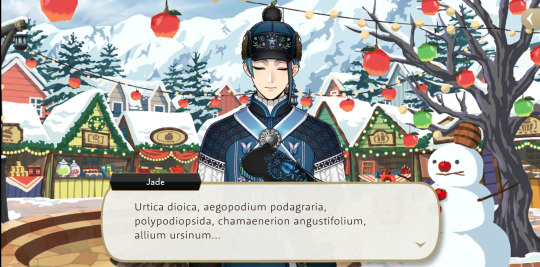

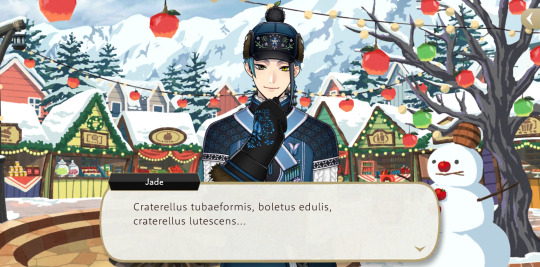
i'm not sure if everyone has gotten to this part in the new english server event yet, but this part when they were at the market got me curious. so, in typical me fashion, i committed a day of research to figure out what the hell jade was talking about.
first i would like to say that this was put together with A DAYS WORTH OF RESEARCH so if you know more about these plants/mushrooms and would like to add information or correct me please do so in the replies!! i'm not an expert by any means LMAO
with that said, onto the first plant!! i will list the scientific name that jade uses first and then the common name in parentheses. each plant/mushroom will have a picture after the short description for reference!!
i got all these images from google obv
~~~~~
Urtica dioica (Stinging Nettle) - A perennial herb that grows best in moist areas. Grows in late fall to early spring. Fall sun, partial shade. Used as an herbal remedy for sore muscles and seasonal allergies.

Aegopodium podagraria (Ground Elder) - Marked as an invasive species in some of the eastern states of the US (Pennsylvania, Connecticut, New Jersey, Vermont, Michigan, and Wiscousin.) Thrives in moist soil and grows during the summer. It’s commonly used in soup and as a remedy for gouts.

Polypodiopsida (Ferns!!!) - Thrives in moist soil and grows near rivers and creeks. Grows in shady locations in early spring. They reproduce with spores. Fiddlehead ferns are the curled up fronds of a young fern that can be cooked and eaten in various ways (steamed, fried & stored, roasted, pickled, etc.) They can also be used as fertilizer and for landscaping.
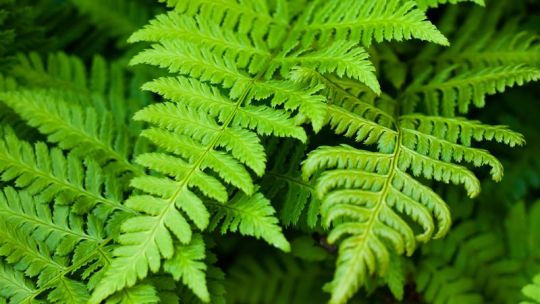
Chamaenerion angustifolium (Fireweed) - A perennial herb that flowers in June to September. Grows in full sun to partial shade and moist, well drained soil. Its primary use is medicine but it’s also used in tea, which in turn can be used to treat migraines, infections, and colds. Young fireweed shoots can be cooked and eaten (apparently, they taste like asparagus and should be cooked like them, too.)
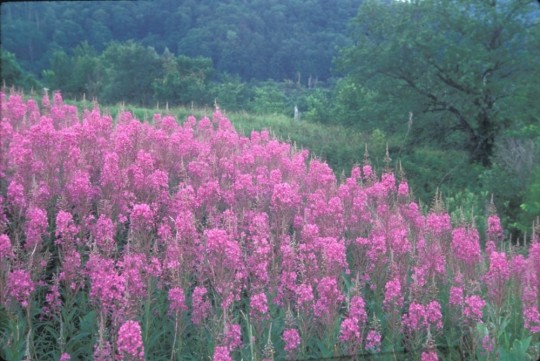
Allium ursinum (Wild Garlic or Cowleek) - Thrives in slightly acidic soil & moist conditions. Prefers shady conditions and grows around winter to spring, with a peak season of February to April. You can eat basically the whole plant, but if you eat the bulb the plant obviously won’t grow back. It’s been used as a medical plant and in cooking.
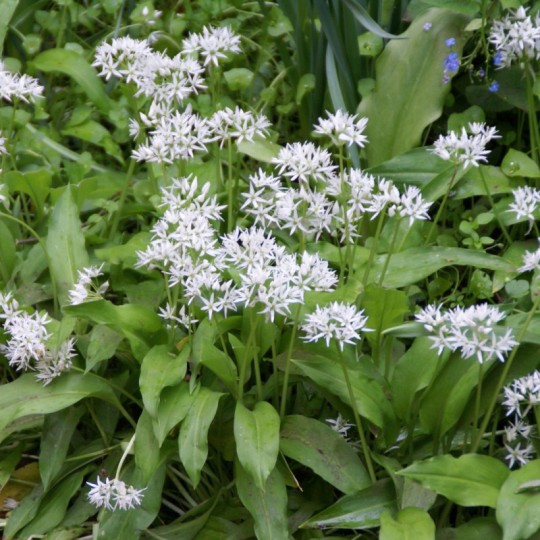
Sorbus (Mountain Ash or Rowan) - A bush that produces edible berries in late summer into early fall, and they stay on the tree into winter. The berries should not be eaten raw, but should be cooked because they contain parasorbic acid. The cooking process converts the parasorbic acid into a preservative sorbic acid. Their astringent taste is made sweeter by the frost. They grow best in full sun to partial shade and moist, well drained soil. They usually grow up to 15 meters tall.

Plantago major (Broadleaf Plantain) - A perennial herb that grows in late spring to summer (and sometimes in autumn.) They prefer moist soil but are very adaptable. Grows in moderate shade to full sun. The entire plant is edible, but apparently the flower shoots are especially delicious. They naturally grow in very dense populations and are easy to harvest. Works as a medicinal herb to treat inflammation and boost the immune system.

Equisetum arvense (Field horsetail) - Another perennial herb that grows from summer to the first frost. Grows in moist soil with full to partial sun. Can be used in tea and benefits the urinary system. Their root systems can grow as deep as six feet.

Craterellus tubaeformis (Winter mushroom, or funnel chanterelle) - Our first mushroom!! They are featured in a lot of recipes and are fairly common. They’re ready to harvest in mid-winter to mid-spring. They can be found in mossy areas with well decayed wood, and grow in loose clusters. They apparently have an earthy/fruity taste, and should be cooked so they don’t taste unbearably peppery.

Boletus edulis (Penny Bun) - Another mushroom with a dark brown cap. Spores grow more mushrooms in summer and autumn. Thrives in moist soil and can be harvested a few days after summer rain. They’re around 25cm tall on average and can weigh a kilo (which made me yell out loud, mind you. That's a big mushroom!!) They have a slightly nutty flavor.

Craterellus lutescens (Yellow Foot) - The last item on this list is another mushroom. It thrives in moist soil and they grow from 2-7 cm in length. They apparently have a peppery flavor when raw, but taste earthy when cooked. They typically grow around moss in loose clusters. They’re pretty similar to the craterellus tubaeformis, as one would expect from their shared genus, “craterellus.”

~~~~~
Overall Plant Conditions (AKA patterns I noticed while researching):
Practically all of these plants love moist & well drained soil. A lot of these plants grow in the summertime and like full/partial sun, but there’s a few exceptions of course. There’s a lot of herbs and perennial greenery that have medicinal properties. Many plants on this list grow well in disturbed soil or near water and roadways. All of them are edible (but beware of dangerous lookalikes!)
anyways < jade leech 3 i hope you found this somewhat interesting because i sure did!! (which is why i spent all my free time today researching it sigh the things i do for mermen)
#auburn's rambles <3#gonna make that a tag#jade leech#twst jade leech#disney twisted wonderland#twisted wonderland#disney twst#the harveston sledathon#auburn's fungi time <3
180 notes
·
View notes
Text

Planet Mars: Astrology, Associations, Healing & Magick
-Talon Abraxas
Mars and Magick
The energy of Mars may be invoked in magical workings dealing with warriors, war or battles, attack or defense, increasing or preserving physical strength, courage, or sexual potency.
It can also be invoked to break binding spells and love spells and to counter or protect against any spells using Venus energy. Mars energy lends itself well to spells to induce lust and passion, but not love and devotion.
Herbs Associated with the Planet Mars
Thorny and/or red plants are often associated with Mars as are those with a strong, spicy flavor and the ability to warm and stimulate or energize the body.
A list of 50+ herbs associated with the planet Mars:
Acacia,
Agapanthus,
Aloes,
All-Heal,
Asafoetida,
Asarabacca,
Ashwagandha,
Barberry,
Basil,
Belladonna,
Betony,
Black cherry,
Black gum,
Blue cohosh,
Broomrape,
Bryony,
Buckbush,
Butterbur,
Butcher’s broom,
Cacti,
Calamus,
Caper,
Cardamom,
Cardoon,
Cassava,
Catnip,
Chicalote,
Chickweed,
Chives,
Coneflower,
Coriander,
Corn salad,
Cow Parsnip,
Cypress,
Dandelion leaf,
Devil’s claw root,
Dragonhead flower,
Dragon tree,
Field horsetail,
Flax lily,
Garlic,
Gentian,
ginger,
Gobo,
Gorse,
Guanique,
Hawthorn,
Holly,
Horseradish,
Hyacinth,
Japanese knotweed,
Kola nut,
Lamium,
Maca,
Madder Root,
Madwoman’s Milk,
Masterwort,
Mistletoe,
Mugwort,
Mullein,
Mustard,
nettles,
Onion,
Pepper,
Pepperwort,
Pennyroyal,
Pigweed,
Radish,
Red cedar,
Red clover,
Red-hot poker,
Reed,
Resurrection lily,
Rowan,
Rue,
Safflower,
Sarsaparilla,
Solandra,
Tea,
Tarragon,
Thistle,
Thyme,
Toadflax,
Tomatillo,
Turmeric,
Wild ginger,
Wild tobacco,
Wormwood,
Yohimbe
Crystals Associated with Mars
Any red stone can be used to represent Mars including ruby and garnet. Bloodstone also contains Mars energy.
Other Correspondences
Mars is associated with Tuesday, and in Romance languages, the word for Tuesday often resembles Mars (in Spanish, Martes, and in French, Mardi). Dante Alighieri associated Mars with the liberal art of arithmetic.
The color red, the-tower tarot card, the sword, and the pentagram are all symbols of Mars.
The horse, the bear, and the wolf are also associated with Mars.
45 notes
·
View notes
Text
Suddenly the king cried to Snowmane and the horse sprang away. Behind him his banner blew in the wind, white horse upon a field of green, but he outpaced it. After him thundered the knights of his house, but he was ever before them. Éomer rode there, the white horsetail on his helm floating in his speed, and the front of the first éored roared like a breaker foaming to the shore, but Théoden could not be overtaken. Fey he seemed, or the battle-fury of his fathers ran like new fire in his veins, and he was borne up on Snowmane like a god of old, even as Oromë the Great in the battle of the Valar when the world was young. His golden shield was uncovered, and lo! it shone like an image of the Sun, and the grass flamed into green about the white feet of his steed. For morning came, morning and a wind from the sea; and darkness was removed, and the hosts of Mordor wailed, and terror took them, and they fled, and died, and the hoofs of wrath rode over them. And then all the host of Rohan burst into song, and they sang as they slew, for the joy of battle was on them, and the sound of their singing that was fair and terrible came even to the City.
another jolkien's banger!! they sang as they slew!! grass flamed into green about the white feet of his steed!!!
#also comparing him to orome............... top tier#theoden#lotr newsletter#it's mine my own my precious
175 notes
·
View notes
Photo

Precious opal (Andamooka Opal Fields, South Australia)
Opal is hydrous silica (SiO2·nH2O). Technically, opal is not a mineral because it lacks a crystalline structure. Opal is supposed to be called a mineraloid. Opal is made up of extremely tiny spheres (colloids - www.uwgb.edu/dutchs/acstalks/acscolor/OPALSPHR.jpg) that can be seen with a scanning electron microscope (SEM).
Gem-quality opal, or precious opal, has a wonderful rainbow play of colors (opalescence). This play of color is the result of light being diffracted by planes of voids between large areas of regularly packed, same-sized opal colloids. Different opalescent colors are produced by colloids of differing sizes. If individual colloids are larger than 140 x 10-6 mm in size, purple & blue & green colors are produced. Once colloids get as large as about 240 x 10-6 mm, red color is seen (Carr et al., 1979).
Not all opals have the famous play of colors, however. Common opal has a wax-like luster & is often milky whitish with no visible color play at all. Opal is moderately hard (H = 5 to 6), has a white streak, and has conchoidal fracture.
Several groups of organisms make skeletons of opaline silica, for example hexactinellid sponges, diatoms, radiolarians, silicoflagellates, and ebridians. Some organisms incorporate opal into their tissues, for example horsetails/scouring rushes and sawgrass. Sometimes, fossils are preserved in opal or precious opal.
Locality: unrecorded locality in the Andamooka Opal Fields, ~eastern edge of the Stuart Range Plateau, west of northern Lake Torrens, southeast-central South Australia (environs of 30° 26' 50" South latitude, 137° 09' 55" East longitude)
255 notes
·
View notes
Text


Stolas is a Great Prince of the Underworld and a powerful daemon mentioned in Ars Goetia and Pseudomonarchia Daemonium.
According to these grimoires, Stolas appears to the magician as an owl and teaches the arcane art of astronomy, the knowledge of herbs, and the value of precious stones. He is a mighty companion to a mage that wants to learn more of the craft and art of demon work.
Stolas is a daemon I am personally close to, and owe a lot to for helping me in my path. I’d like to speak on some offerings that one can make for Him as well as a simple ritual to invoke Him were you to want it.
Note: All suggestions are based on just my experience.
Don’t take it as a guide.




These are some non-poisonous plants and herbs I can suggest for Prince Stolas:
⋆ Asafoetida
✩ Basil
⋆ Bergamot
✩ Black pepper
⋆ Cassia
✩ Clove
⋆ Fennel
✩ Verbena
⋆ Licorice
✩ Star anise
⋆ Sage
✩ Agave
⋆ Jasmine
✩ Barrenwort
⋆ Blackberry
✩ Dark opal basil
⋆ Dusty miller
✩ Fern
⋆ Lady's mantle
Stolas is a daemon governing poisonous plants, which is why I will enlist some.
Do NOT eat those and avoid touching them without first learning whether or not it’s safe.
Do NOT let your pets eat these.
✩ Aconitum Napellus
⋆ Pyracantha
✩ Amaryllis hippeastrum
⋆ Gypsophila
✩ Morning Glory ☾ purple/pink ☽
⋆ Wisteria
✩ Delphinium
⋆ Sweet Pea
✩ Horsetails
⋆ Golden Star
✩ Moonwort
⋆ Star Grass
✩ Hostas
⋆ Coleus

Precious stones are said to be Stolas’ field, which is why I find them very important in invoking Him as well as routinely approaching Him:
🜃 Papagoite quartz
🜁 Star rutilated quartz
🜃 Kunzite
🜁 Dioptase
🜃 Space peridot
🜁 Meteorite pieces
🜃 Crystals shaped to resemble the 7 Planets
🜁 Crystals for each of the 7 Planets:
☿ Clear quartz ✦ Volcanic rock quartz 『 Mercury 』
♀ Brown jasper ✦ Serpeggiante 『Venus』
☉ Lapis lazuli ✦ Sodalite / Blue calcite 『 Earth』
♂ Spessartine garnet ✦ Hematite coated quartz 『Mars』
♃ Tiger’s eye 『Jupiter』
♆ Cat’s eye ✦ Tanzanite 『Neptune』
♄ Red jasper ✦ Citrine 『Saturn』
⛢ Angelite ✦ Larimar ✦ Aquamarine 『Uranus』
♇ Black onyx ✦ Hematite 『Pluto』

Many of the objects I’d like to suggest are related to the art of astronomy. You do not need to get expensive telescopes or other tools, you can get very cheap ones as well:
🜙 Spyglass
🝐 Telescopes
🜙 Astronomical clocks
🝐 Armillary spheres
🜙 Celestial sphere
🝐 Alembic
🜙 Astrolabe
🝐 Quill
🜙 Lenses & oculars
🝐 Small alchemy bottles
🜙 Alchemical scales
🝐 Richly textured fabrics
🜙 Feather crafts
🝐 Coins
🜙 Jewelry with precious stones
🝐 Metalcraft
🜙 Metal dice
🝐 Pendulums

I have to make it clear that all of these objects are to be acquired ethically. Body parts of roadkill, those you found on the ground or in a forest, or perhaps ones you already own will do.
Do consider the laws of the place you live in before picking up roadkill.
🜥 Bones of owl prey: mice, rodent-like mammals, rabbits, birds, squirrels
🜛 Skin of snakes and lizards
🜥 Eyes and body parts of frogs
🜛 Tails of lizards
🜥 Owl pellets
🜛 Owl claws, skulls, and feathers

While Prince Stolas can be a great companion and ally in the field of academics, you can do simple, daily things with and/or for Him, too. Here are some of my ideas:
✧ Having your own garden of poisonous plants is a great idea to honor Him. Do not have it out in the open unless you can secure access to your property so no animal or human can accidentally hurt themselves by interacting with your plants.
༓ Feeding birds whenever you have a chance to might appease Him, as He is represented as a great owl.
✧ Jewelry making might be a good idea. You can make jewelry for or with Him, offer it up after, wear it, charm it, or devote it to Him.
༓ Stone polishing is one of the high-skill tasks I’d like to offer. While you do need special equipment and skill to do it, if you can safely learn this craft or already know how to do it, it is a good way to interact with Stolas.
✧ Investing into arcane arts and practicing alchemy in a safe way is a great way to bond with Stolas, as He’s said to be a Scientist and Alchemist.
༓ You could buy a very cheap telescope, if your funds allow you to, and watch the night sky to try and memorize the stars as well as generally learn more about astronomy.
✧ In addition to stargazing, you can create a star map journal, pages on astrology or astronomy for your book of shadows if you have one, or a magical side journal to keep track of Lunar phases, planetary movement, and properties of the celestial bodies.
༓ You can create a list of personal correspondences of planets and their properties to deepen your understanding of Arcane magic.
✧ Learning how to tell time or location by the stars.
༓ While this might take some time to master, you can communicate with Stolas through stargazing. Twinkling of the stars and celestial movements could be tracked and recorded to further identify them with certain responses you and Him agree on.
✧ Having a journal on herbalism or precious stones could further your communication with the daemon. You can invest into learning more of your region’s native plants and stones to localize your craft, too.
༓ Creating devotional objects with bones or ethnically acquired animal body parts or investing into bird taxidermy, if you can afford it.
✧ You can craft more objects, too, including pendulums or other magical tools you’d like to use in your demon work.
༓ Numerology is sacred to a lot of daemons, so creating personal number sigils, mandalas, numerical codes, and otherwise number-based magic tools would not be out of realm of possible devotional activities for Stolas.
✧ Drawing Him personal portraits, sculpting busts, or otherwise depicting His image is a good way to honor Him.
༓ And lastly, you can do simple offerings for Him where you place the objects you want to give Him in a bowl, which can include fruits, nuts, and otherwise foods that He prefers.


Everyone’s approach with demon work is going to be different. This ritual isn’t mean to be universal, but I believe it’s a relatively simple beginner level rite that everyone can do as all the materials involved in it are easily accessible.
Be aware of fire safety rules.
For this ritual, you’ll need something to write with, a piece of paper, a bowl (preferably tin), herbs of choice, and a pendulum (optional). It’s preferable you start doing this ritual after sunset.
On the paper, draw Stolas’ sigil, whether it’s one you personally made for Him or one from Ars Goetia. I will not be linking it here, as I am not to invoke Him, but you can access the grimoire in the list of my sources.
After the sigil is drawn, wrap your chosen herbs you’ve picked to represent Stolas in this piece of paper. You can activate the sigil in any way you’d like prior: by looking at it, smearing your saliva or other fluids over it - this is up to you. You can chant during this process, call out for Him, or simply think of Him.
After that is done, place the wrapped sigil in the bowl and leave it, preferably under moonlight, or underneath the stars if outside, for the night. Before sunrise, discard the sigil by burning it in the bowl or, if you can’t burn it, tearing it apart and placing it in the bowl. This specific ritual is designed for burning or tearing of the sign, but if you can incorporate your personal means of sigil work here, feel free to.
While the sigil is burning, or while it’s in the bowl, you can optionally use pendulum for spirit communication with Stolas or simply call onto Him. Either way, if you feel that the ritual has been accepted by the Prince, you’ll feel His presence soon.

Sources in my pinned.
#𓆩⛧𓆪 ˣ 𝐃𝖆𝖊𝖒𝖔𝖓𝖎𝖚𝖒#witchblr#witchcraft#witches of tumblr#demonolatry#demonology#demon work#ars goetia#stolas
158 notes
·
View notes
Text
Traintober 2023: Day 21 - Roots
Terence Hates Weeds:

Terence the Tractor works on a farm near Hackenbeck, on Thomas’ branchline. He’s a pleasant sort, but he can be rather cheeky, and a little impatient. Once upon a time, he’d saved Thomas from a deep snow drift, and ever since the tractor had always been the first to remind Thomas to be careful whenever the snow began to fall.
“Do be careful, Thomas,” he chortled. “I might not be able to pull you out if you get stuck this time!” Thomas often ignored him when he got like this.
Terence’s farm was often all but barren during the winter. Terence was only started up to go and check on the cows that lived in the far paddock, but otherwise he spent his winter days dozing in his shed.
One morning, however, he awoke to the farmer flinging open the door.
“That sodding weeds are back!” he grumbled. Terence groaned. The last of the frost had only just melted away!
One thing that the farm often had to contend with was weeds – and one particular type was continuously causing the farm trouble was horsetail. Horsetail weeds could spread their roots deep into the ground, making it almost impossible to full dig them out. Furthermore, they spread rapidly: one day, it was one, then the next it was four, then sixteen, and by the end of the week the field was covered, and the harvest was ruined.
The weeds also resisted everything Terence and the farmer did to remove them. Mowing had down nothing, burning them had only worked to remove the visible plant and weedkillers couldn’t penetrate through its rubbery skin.
So instead, Terence was coupled to a large tanker of lime.
“We’ll begin by liming the soil,” the farmer said. “Then, we’ll burn the lot of them, dig up the tubers and be rid of this menace!”
Terence was excited to begin – though his excitement dimmed when he realised just how boring it all was. He dragged the tanker across the field a number of times, then sat beside the line and waited while the farmer set fire to the horsetail weeds.
That was when he heard a familiar horn.
“What’s going on?!” exclaimed Mavis, looking horrified. Terence was confused.
“Um…”
“Quick! Driver! We must rescue Terence from the fire!”
“Wait…” Before Terence could protest, Mavis’ driver had grabbed a coil of rope and tied it around his bumper. The other end was tied to Mavis, and the diesel began to pull Terence away from his field as quickly and carefully as she could.
“Mavis! Stop!” shouted Terence. “The farm isn’t on fire!”
Mavis stopped.
“What?”
“The farm isn’t on fire,” spluttered Terence indignantly. “We’re burning off weeds!” Mavis winced.
“Oh… sorry. Um…” The two paused – Terence looked down and groaned. His caterpillar tracks had gotten caught in a gnarled tree root. Mavis chuckled nervously, and hurried away with her stone trains.
“How’d you do that?!” exclaimed the farmer.
“Mavis thought the farm was on fire, and wanted to save me,” Terence replied. “I tried to tell her, sir.” The farmer could only sigh.
“It’s nice that you have such good friends, Terence, but they need to leave you alone so you can do your job!”
At that moment, a cheerful whistle peeped from behind them.
“Oh no…” groaned Terence.
“Need a little help?” asked Thomas cheekily. “Though I might not be able to pull you out, seeing as you’re stuck this time.”
Terence groaned – all this, and because of some annoying weeds with deep roots.
Back to Master Post
#fanfiction writer#railway series#weirdowithaquill#thomas the tank engine#railways#traintober 2023#traintober#terence ttte#ttte terence#horsetail#horsetail weeds#ttte thomas#ttte mavis
22 notes
·
View notes
Text
Dead Wood Isn't Dead Weight in Habitat Restoration
I've been slowly rewilding my yard; almost every plant growing in it when I moved in was non-native, from purple foxglove (Digitalis purpurea) to sheep sorrel (Rumex acetosella) to at least four species of non-native grasses. The natives were sparse, mostly limited to beach strawberries (Fragaria chiloensis), trailing blackberry (Rubus ursinus), and field horsetail (Equisetum arvense), along with a few native shrubs like salmonberry (Rubus spectabilis) and twinberry honeysuckle (Lonicera involucrata).
A lot of what I've been doing is removing non-native species while introducing native ones. It's been an uphill struggle since the non-natives are largely species that have evolved to quickly colonize disturbed land and out-compete most of the natives, which has meant a LOT of weeding. In some cases when I've had to open up entire areas of the yard that will have heavy foot traffic, I've had to sow various clovers as a quick solution to keep the other non-natives from crowding their way in. Clover, at least, is easier to remove, and once I have a chance to kill it it will release the nitrogen it has collected into the soil, making it a better spot for whatever I plant there next.
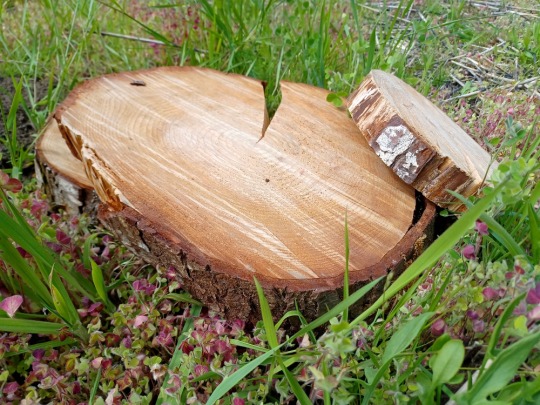
This morning before I started work I decided to get just a little more gardening in. I had these three log slices I was given a while back; the largest is over a foot in diameter. I decided to use them to create a small woody debris pile in one part of the yard that was rather sparse on such things. It's nothing too fancy; they're simply leaning on each other to create a little space underneath.
But these are important additions to this habitat in progress. Lots of living beings rely on dead wood for food or shelter--or both. While these wood slices look pristine now, it's likely that in the next few years they'll collect an array of inhabitants, from lichens and moss to insects and bacteria. Some of these will simply take up residence in the shelter I've created; others will do their part as decomposers and break down the cellulose and lignin in the wood. Eventually, if left in place, the slices will eventually return to the soil, adding to the nutrient load being passed around from being to being in this ecosystem.
Most often when woody debris is mentioned in habitat restoration, the focus is on large example like entire snags, nurse stumps, and nurse logs, or on dead trees piled up in rivers and streams. These are, of course, important examples thereof. However, many people don't have the space for an entire dead tree in their yard. In that case, smaller installations are perfectly reasonable and will still create habitat for your local wildlife like insects and other arthropods, snakes, toads, etc.

I also took the opportunity to take a quick peek at a stack of red alder (Alnus rubra) logs I had set up a couple of years ago. They'd already brought their own patches of moss, but the wet weather and resident decomposers have been doing their work, and the bark is beginning to slough off of some of them.

The previous owner of this property did some landscaping with dead wood; this is probably the largest, an old log about five feet long that I think looks a bit like an alligator's head. As you can see, it's pretty weathered at this point; the old knot has rotted out and the remaining wood has numerous cracks and splits, and the bark has long since decayed.
I'm going to keep adding small wood piles around the yard as I'm able to make space for them. They do need to be worked around when I'm attending to live plants, and can be an obstacle to mowers and other tools. I want to not have to disturb these little habitats once they're established, so I'll be adding them in deliberately. This sort of planning is important if you're going to be creating woody debris piles in your yard as well, so that your local wildlife are free to set up their homes without worrying about sudden eviction. If you're in an area with venomous snakes, or if you're concerned about termites or carpenter ants using a wood pile to hopscotch over to the wood in your home, you may want to make sure you create habitat further away from the house and other buildings. Finally, make sure that no one uses these piles as jungle gyms; the animals living inside them can be easily crushed if the wood is shifted around or compressed.
Did you enjoy this post? Consider taking one of my online foraging and natural history classes, checking out my other articles, or picking up a paperback or ebook I’ve written! You can even buy me a coffee here!
#habitat restoration#ecology#nature#wildlife#animals#plants#fungi#science#scicomm#gardening#garden#outdoors#environment#environmentalism#conservation#long post#rewilding
294 notes
·
View notes
Text

【庭】スギナが出てきた。葉の先端に水滴がついている。五重塔みたい(2月26日)
Skrzyp polny (Equisetum arvense)
field horsetail or common horsetail (Equisetum arvense)
14 notes
·
View notes
Text
Suddenly the king cried to Snowmane and the horse sprang away. Behind him his banner blew in the wind, white horse upon a field of green, but he outpaced it. After him thundered the knights of his house, but he was ever before them. Éomer rode there, the white horsetail on his helm floating in his speed, and the front of the first éored roared like a breaker foaming to the shore, but Théoden could not be overtaken. Fey he seemed, or the battle-fury of his fathers ran like new fire in his veins, and he was borne up on Snowmane like a god of old, even as Oromë the Great in the battle of the Valar when the world was young. His golden shield was uncovered, and lo! it shone like an image of the Sun, and the grass flamed into green about the white feet of his steed. For morning came, morning and a wind from the sea; and darkness was removed, and the hosts of Mordor wailed, and terror took them, and they fled, and died, and the hoofs of wrath rode over them. And then all the host of Rohan burst into song, and they sang as they slew, for the joy of battle was on them, and the sound of their singing that was fair and terrible came even to the City.
No matter how many times I read this, I still get goosebumps.
9 notes
·
View notes
Text
Barosaurus and the Morrison Formation.





I just finished all my final projects and graduated from my high school, meaning i finally have the time to start posting again! This was a project I made for my high school art class where i had to illustrate something into 4 quadrants, each quadrant being done with differing materials. I was originally considering doing my sophont species: the Xy'ktals. But decided to do something more paleoart related since it was outside of my comfort zone at the time. This project took me almost 2 months to make, I started working on it in late march and submitted it in late may. And almost half of it was spent researching the life of this formation and trying to accurately reconstruct it. I hope you all enjoy this art piece
My Statement
As an artist who loves the natural world, I became fascinated with the field of paleontology long before I discovered my love for the possibility of alien life. I was introduced to the field by the Jurassic Park film franchise and was thrilled by all the big monsters made to scare. I bought their toys, watched most of the movies, and enjoyed most of it.
Eventually I phased out of Jurassic park. Many years later, when I was into designing aliens, I found a youtuber who made me rethink how I designed alien life. Teaching me that the human body plan is far from universal and we would likely make first contact with something that looked more like a jellyfish or a worm than a human.
While browsing through their other videos I found out they did paleontology, and once again my eyes were open. To see what the natural world looked like before mankind came to be was amazing. Getting to see plants and animals beyond my wildest dreams, so different they might as well be considered aliens. Yet they felt familiar, they felt relatable. That is what made me fall in love with the field.
Nowadays I casually look into paleoart, looking into the depths of time and into the earliest ages of life as inspiration for my own alien worlds. While working on this assignment, I realized that not many people are up to date with the modern idea of the prehistoric. Most still think of them as scaly screaming scrawny slaughter machines. Some might even still think of them as the lumbering dim-witted kangaroo-like lizards of the 1800s to 1900s. With this work i intend to change that
My goal with this assignment wasn’t just to draw dinosaurs, but to show everyone just how amazing the prehistoric world was. But most importantly, these were animals at the end of the day, not movie monsters made to scare. They lived simple lives of joys and sorrows, felt love, played with each other, and found happiness in the small things. They were no different than the animals of the modern world.
Introduction
To showcase this, I drew the many species that lived in the Morrison formation of Colorado, Wyoming, and Montana. A basin of sedimentary rock dating to the Jurassic period 150 million years ago. Back then this place was a semi-arid environment, home to swamps, floodplains, and savannahs. But this place didn’t look like modern savannahs now.
For one, angiosperms such as flowers, leafed trees, and grass only evolved some 10 million years after all the dinosaurs went extinct. Meaning almost none of the familiar plants were present in the jurassic. Instead of our familiar faces, Conifers, Cycads, and Ginkgos took the role of trees, horsetails were a common sight, and Ferns took the niche of grass. In fact Ferns were so prevalent they became their own biome known as the Fern Prairies
The animals are also far different too. Unlike the depictions spurred on by Jurassic park, of big, gaunt, and mindlessly ravenous reptiles designed to kill. Through finely preserved fossils we now know most of them were covered in varying degrees of feathers. Some may have had simple hair-like feathers while others were almost birdlike in appearance, since birds actually evolved from dinosaurs.
Pretty much every dinosaur that didn’t have a beak had lips covering their teeth. Their hands would have faced each other rather than pointing downwards. Lastly we know that pretty much all of them were covered in enough fat and muscle to not have every detail of their bones poking out like a starved animal
The winged bird like-creatures named Pterosaurs too have changed a lot. We now know they were also covered in fur, and were possibly brightly colored too. their hands faced each other in the same way the dinosaurs did. Surprisingly they walked on the balls of their feet like us, and some were even postured like us too.
Barosaurus: the main star
The dinosaur that’s the focus of this piece is a young male Barosaurus as he stands near a conifer tree. Relaxing in the cool moist air brought on by the passing rain of a Cumulonimbus cloud
Barosaurus was an enormous species of herbivorous dinosaur that helped define the Morrison formation along with many other species. They were a part of the clade Sauropoda, a group of herbivorous dinosaurs renowned for their extremely long necks and equally long tails.
Barosaurus wasn't the longest or the strongest sauropod. but it was still impressive at a staggering 82-89 feet long. This behemoth was so huge their front arm alone was as big as a human.
Most sauropods had a uniquely weird set of feet. The hind feet were round and had 3 toe claws that pointed outward. While the front feet were horseshoe shaped, with the fingers all fused together and an empty space at the center. Only the “thumb” has a claw while the rest of their fingers were bare, save for possibly a collection of jagged scales that aided in traction.
Like mentioned earlier, Barosaurus was an herbivore that specialized in high level browsing. They were also surprisingly flexible, the structure of their neck vertebrae gave them a wide range of motion, allowing them to eat tons of plant matter in wide sweeping motions without having to move an inch.
Despite their sheer size, the juggernauts of the Jurassic were still preyed on from time to time by Allosaurus and maybe Ceratosaurus. To counter this, the Barosaurus has a few weapons at its disposal, It could possibly rear up on its hind legs to make itself look even larger or even to stomp on incoming attackers. But its greatest weapon was its tail. It was thin and flexible, allowing the Barosaurus and its relatives to whip at their attackers with a thunderous crack, stunning the predators and possibly leaving long stinging cuts in them.
Speculated here, the Barosaurus was given a vibrant set of brown and black patterning as a way to distinguish themselves from other sauropods. They possess a large black dewlap to displace heat all in one area while the main body remains light in pigment and the head mostly white. Several Eye-like patterns run down the neck as a form of sexual display as they could potentially swing their neck around as a display of their flexibility to mates. The tail by contrast is a bright green as both a warning sign to predators and a way to communicate with other barosaurs. And long spines run from the head to the tip of the tail, making their whips even deadlier to any predator even considering going after them.
And now It's time to talk about all the other species that make this formation famous. Organized from left to right
Tile 1: Graphite pencil and Fine art pen
An Ophisthiamimus basks under the sun on a rock in the foreground. They were a 3 inch long reptile that specializes in insect feeding.
Despite its lizard-like appearance it was actually a Rhyncocephalian. A near extinct order of pseudo-beaked reptiles that dominated the early mesozoic, but were beaten back by tue lizards. The only surviving species of this clade is the Tuatara of New zealand
An old bull Brachiosaurus wanders across the drylands. They were a tall species of sauropod dinosaur that had a length of 57-72 feet long and weighed 28-47 metric tons. They were so big their forearms were as tall as an adult male. They Were herbivorous and browsed on high up plantlife such as the leaves of conifer, ginkgo, cycad, and tree fern leaves.
Speculated here, they could have had a large and flappy dewlap to displace heat. They may have also had several sets of inflatable neck sacs for sexual display since it was found internal air sacs ran down their neck and invaded their bones to reduce weight.
A small herd of very young Dryosaurs head towards the brachiosaurus for protection, in the same way a school of small fish orbit around a whale.
Dryosaurus was a species of small and nimble ornithiscian dinosaur that may have grown to be 7-9 feet long. They were Herbivores that fed on low lying plantlife, picking them out with their pointy beaks before chewing them with a set of cheek teeth.
So far no fossils of fully grown Dryosaurus have been found yet, so illustrated here instead are very young members of this species. Heavily Speculated here, they might've had a set of feathers turned quills on their tails and arms to stop larger predators from grappling on them. This feature was purely speculative and might've never existed on them.
A female Harpactognathus catches an unnamed early mammal from a hole in the ground. They were an extinct species of generalist pterosaurs that hunted small inland vertebrates and had a wingspan of 8.2 feet long. They were a part of the family Rhamphorynchidae, an early group of pterosaurs known for possessing toothy beaks and a long, thin tail.
Tile 2: Colored pencil and fine art pen
A young male Allosaurus tries to get with a female of the same species with his elaborate courtship dance. Flailing his arms, rhythmically stomping the ground and bowing his head to reveal the bright red crest, the female however is unimpressed.
Allosaurus was a species of 28-32 froot long theropod dinosaur that was one of 3 apex predators of the Morrison formation. They were discernible by the 2 pointy crests above their eyes. They specialized in hunting large prey such as stegosaurus and will sometimes come together in packs to even hunt sauropods such as Brachiosaurus and Barosaurus. They would've used their short but sharp teeth to slash into prey like a machete and used their short but muscular arms to hold onto their prey.
Speculated here, they could have sported black stripes and white splotches in an attempt at disrupting its outline and masking its eyes and ears. As well as having intricate mating dances that would've shown their flexibility and persistence.
A young female dryosaurus hides behind the Barosaurus' leg, waiting for the perfect opportunity to avoid the allosaurus and reunite with the herd.
A male harpactognathus takes off on the back of the Barosaurus. Speculated here, they could've had some sexual dimorphism like their azhdarchid cousins
2 Mesodactylus play around on top of the back of the Barosaurus/
They were a small species of pterosaurs that belonged to the family Anurognathidae, a group of small round and furry pterosaurs. They were estimated to be between 4-5 centimeters in length.
Sadly not much speculation went into them, other than a faint stripe on the underside of their wings, and the potential presence of play behavior. Something seen in all young mammals, some reptiles, fish, and even bees.
Tile 3: watercolor paint, a bit of acrylic paint, and a bit of Graphite pencil
A herd of Camptosaurs run towards a lake after a long odyssey across the muddy drylands
They were a species of medium sized Ornithopod dinosaurs that were 20 feet long and 6 feet tall. They were somewhat related to the previously mentioned Dryosaurus but are closely related to Iguanodon. One of the first dinosaurs ever discovered and named. They have 5 fingers on their front arm but only the front 3 end in claws
They were somewhat slow herbivores that may have lived in small herds, browsing on medium sized plants and competing with the many similar sized herbivores in the region.
A pair of male Gargoylesaurs rest under a conifer tree
Gargoylesaurus was a small species of armored herbivorous dinosaur ranging from 10-11 feet long but less than 3 feet tall. They are an early member of the family Nodosauridae in the Suborder Ankylosauria, meaning this dinosaur is related to the somewhat famous Ankylosaurus.
Not much was speculated here other than the presence of a blue stripe running down their face as a form of sexual display
A lone Cycad tree amongst the fern prairie
Tile 4: Digital art
A stegosaurus gets inspected by a young and curious Ceratosaurus
Stegosaurus was a medium sized herbivorous dinosaur that was 23 feet long and 10 feet tall at the back. They can be easily recognized by the large asymmetrical dorsal plates running down the neck, body, to the tail. As well as the presence of 4 tail spikes named the Thagomizer.
They were herbivores that fed on ferns, horsetails, and cycads with their uniquely crown shaped teeth. They could’ve possibly been carriers for Cycad seeds the same way elephants help disperse the seeds of savannah trees.
Speculated here, the dorsal plates and thagomizer are brightly colored orange as a threat display towards their predators such as Allosaurus and Ceratosaurus.
Ceratosaurus was the second of 3 apex predators of the morrison formation. They were a medium sized carnivorous theropod that ranged from 21-22 feet long and 5.2-6.5 feet tall. They are discernable by the 3 hump shaped crests on top of their head, their long and slender teeth, and the presence of osteoderms running down their body.
They shared the same habitat as Allosaurus, and could’ve possibly fed on similar prey such as stegosaurus, ornithopods, and possibly sauropods. Uniquely it has been suggested that Ceratosaurus could’ve fed on fish too as a way to avoid competition with Allosaurus
Not much has been speculated on their design other than a bright yellow face as a form of sexual display and horizontal stripes possibly as a form of motion dazzle camoflauge.
A Kepodactylus soars across the fern prairie with an unnamed reptile in its mouth.
Kepodactylus was a species of medium-sized pterosaur from the family Ctenochasmatidae, their distinct from other pterosaurs by possessing a crest akin to the later on azhdarchid pterosaurs while also having teeth akin to the Rhamphorhynchoid Pterosaurs. This species had a wingspan of 8.2 feet long
The illustration of them eating a reptile, along with the patterning is entirely speculative as there was very little information to go off of.
Another male Barosaurus observes the one in the middleground, wary on whether or not it could become a friend or foe.
Despite our conception of large herbivores being gentle giants, that idea couldn’t be further from the truth. Many cases in our modern world show large animals such as Goats, rams, boars, water buffalo, rhinoceroses, and even elephants will retaliate against their predators to devastating effects.
Hippos of all animals are the absolute epitome of this truth, they are extremely territorial and frequently kill everything that comes too close. At least 500 people die from them every year. In some cases they will even kill baby hippos that they didn’t have a hand in creating, just to ensure their own bloodline succeeds above all others.
It was very possible that prehistoric life could’ve matched this aggression, if not exceeded it. With the barosaurus’ ability to rear up on its hind legs, It could’ve used this to clash with other barosaurs. Whether it be over territorial disputes, fighting for potential mates, or simple distrust.
A male stokesosaurus basks on a pile of rocks in the foreground, getting ready to fan out its neck plumage to cool off
Stokesosaurus was a 10-13 feet long theropod dinosaur that was apart of the clade Proceratosauridae and the superfamily Tyrannosauridea. Meaning this dinosaur was a somewhat distant relative to the world famous cretaceous era superpredator Tyrannosaurus rex
Speculated here, Their coat of feathers is a stark black to combat UV radiation, they possess a patch of neck plumage that could fan out to displace heat. With the streaks of white stripes helping break up its outline and cool down what could’ve been the heat sensitive parts of its body. They could’ve also had a white underbelly to form countershading
Fun fact: one of my friends has the same last name as the first part of this dinosaur's name, so as a tribute to our friendship I modeled the patterning and coloration of him. The neck plumage a tribute to his hair, and the coloration based off his clothing
#paleontology#paleoart#jurassic#morrison formation#my art#artist on tumblr#cloud art#landscape#dinosaur
21 notes
·
View notes
Text
Climate change is terrifying yet at the same time it's fascinating how nature adapts to it. For example the wild sage grows like crazy right now:



This was a week ago. And it's growing en mass all around here. Previous years I had to look very closely to find a batch.



This is from today. Salvia pratensis' flowering period is supposed to start end of may. And don't get me started on the field horsetail. It's crazy.
2 notes
·
View notes
Text
“At that sound the bent shape of the king sprang suddenly erect. Tall and proud he seemed again; and rising in his stirrups he cried in a loud voice, more clear than any there had ever heard a mortal man achieve before:
Arise, arise, Riders of Theoden!
Fell deeds awake: fire and slaughter!
spear shall be shaken, shield be splintered,
a sword-day, a red day, ere the sun rises!
Ride now, ride now! Ride to Gondor!
With that he seized a great horn from Guthlaf his banner-bearer, and he blew such a blast upon it that it burst asunder. And straightway all the horns in the host were lifted up in music, and the blowing of the horns of Rohan in that hour was like a storm upon the plain and a thunder in the mountains.
Ride now, ride now! Ride to Gondor!
Suddenly the king cried to Snowmane and the horse sprang away. Behind him his banner blew in the wind, white horse upon a field of green, but he outpaced it. After him thundered the knights of his house, but he was ever before them. Eomer rode there, the white horsetail on his helm floating in his speed, and the front of the first eored roared like a breaker foaming to the shore, but Theoden could not be overtaken. Fey he seemed, or the battle-fury of his fathers ran like new fire in his veins, and he was borne up on Snowmane like a god of old, even as Orome the Great in the battle of the Valar when the world was young. his golden shield was uncovered, and lo! it shone like an image of the Sun, and the grass flamed into green about the white feet of his steed. For morning came, morning and a wind from the sea; and darkness was removed, and the hosts of Mordor wailed, and terror took them, and they fled, and died, and the hoofs of wrath rode over them. And then all the host of Rohan burst into song, and they sang as they slew, for the joy of battle was on them, and the sound of their singing that was fair and terrible came even to the City.”

30 notes
·
View notes
